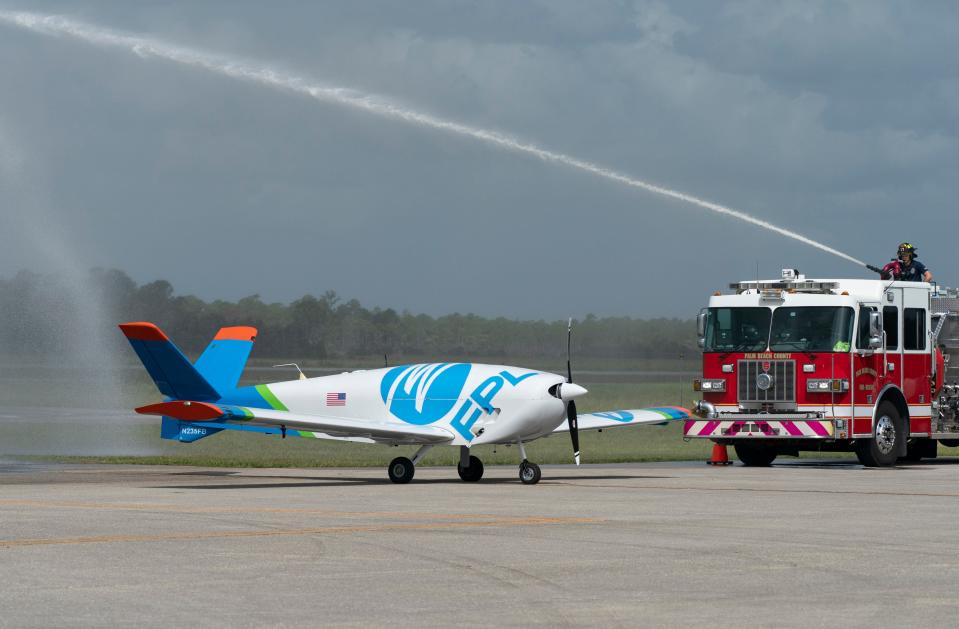Florida Power & Light to use fleet of drones to assess Hurricane Ian damages across Southwest Florida
Florida Power & Light is launching a fleet of drones, including its newest $1.2 million fixed-wing drone, to assess the devastation caused by Hurricane Ian and devise a plan to restore power to millions of state residents.
At an afternoon news conference from FPL's command center in Riviera Beach, company spokesman Brian Garner said information gathered from the flying cameras will allow the utility to tell most of its customers by Friday when they can expect their lights will be back on.

However, Garner warned, it may take longer to figure out how to restore service to hard-hit areas along the state’s Gulf Coast. In some devastated areas, such as Lee, Collier and Charlotte counties, electrical systems will have to be rebuilt, not just repaired.
“Where the grid is destroyed, it could take many days, if not longer,” Garner said.
The storm in photos: Hurricane Ian path of devastation through Florida
Two minutes of terror at Kings Point: Tornado leaves many in 55+ community west of Delray homeless
A night of warnings: Hurricane Ian's outer bands brought 2 overnight tornado alerts to Jupiter area
Drones can assess storm damager faster than FPL crews on foot
State officials estimated that more than 2.5 million households in Florida were without power. Roughly 2 million of FPL's 5 million customers lost electricity during the storm, the company said.
Working between bands of storms on Wednesday and throughout the day Thursday, FPL was able to restore power to 750,000 customers, the company said. That left 1.2 million waiting.
Smaller utilities were also working to restore service. The Lee County Electric Cooperative, for instance, reported that more than 92% of the 238,200 households it serves were without power.
The use of the drones, including the maiden flight of FPLAir One, will enable the state's largest utility to assess unreachable areas that are still under water, where trees have been uprooted and where buildings have collapsed, Garner said.
The assessment will take 24 hours. But, he said, the nearly 21,000 workers it has assembled with help from 30 other states will work around the clock to restore services to as many customers as possible. Specialized crews are clearing downed trees and debris so bucket trucks can get in to do repairs.
Gov. Ron DeSantis said that a total of 42,000 line workers are in the state ready to help turn the power back on for storm-shocked residents.

Several reasons power remains out to 11,000 Palm Beach County residents
Garner said there are a variety of reasons why people are still without power in areas that received little more than a glancing blow from the powerful storm that crossed the peninsula Thursday and is now headed toward South Carolina.
For instance, 11,000 people remained without power in Palm Beach County Thursday morning even though gusts in the West Palm Beach area barely topped 40 mph. By 5 p.m., the company said 6,700 county households remained dark.
Localized flooding in some neighborhoods or isolated tornadoes, such as one that wrecked a condominium complex west of Delray Beach late Tuesday, could contribute to FPL’s inability to repair downed lines, Garner said.
“The goal is to get as many people back on as quickly as possible and always safely,” he said.
Since Hurricanes Frances and Jeanne hit the state's east coast in 2004, leaving thousands without power for weeks, Garner said FPL has been "hardening" its system.
"It's been a journey," he said of nearly two-decade-long efforts to replace wooden poles with concrete ones, bury lines and remove vegetation.
"We've been making sure that our grid is the most resilient in America," Garner said. "That being said, no grid is hurricane-proof."
Jane Musgrave covers federal and civil courts and occasionally ventures into criminal trials in state court. Contact her at jmusgrave@pbpost.com.
This article originally appeared on Palm Beach Post: Drones to help FPL assess damage from Hurricane Ian in Florida

 money
money 